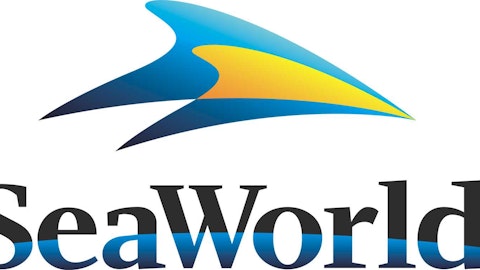With summer approaching, the days are getting hotter, students are starting their vacations, and amusement parks across America are opening to millions of excited thrill seekers. With roller coasters, water rides, shows, and games, amusement parks offer entertainment for everyone. And with over 400 amusement parks in the United States, there is no shortage of attractions for consumers to enjoy until they’re nauseous. Overall, the industry rakes in roughly $14 billion annually and has been projected to reach $37 billion in 2017. This industry is on the up and, unlike the rides, there won’t be a terrifying drop anytime soon. So let’s look at some of the main attractions in the market that specializes in summer screams.

Six Flags’ Second Wind
Six Flags Entertainment Corp (NYSE:SIX) is the largest regional theme park operator in America with 19 amusement parks across North America. Since going public in 1996, Six Flags Entertainment Corp (NYSE:SIX) has experienced its ups and down. Ignoring the obvious roller-coaster joke, Six Flags was hit hard by the housing crisis in 2008, was pulled from the New York Stock Exchange, and filed for Chapter 11 bankruptcy in 2009. After significant and necessary restructuring, Six Flags Entertainment Corp (NYSE:SIX) issued new stock in 2010 at $18. Under the leadership of CEO Jim Reid-Anderson, Six Flags Entertainment Corp (NYSE:SIX) has successfully returned to prosperity and currently has a soaring share price of $78. An advantage Six Flags has over competitors such as Disney and Universal is its location. With 19 amusement parks in North America, there is a Six Flags Entertainment Corp (NYSE:SIX) within driving distance of most Americans. This means that people can use Six Flags as a fun day trip instead of a planned vacation. It’s location that allows Six Flags to keep attendance up during times of economic boom and bust. With revenue of $1.09 billion that yields a net income of $399 million, and quarterly growth (year over year) of 31.90%, Six Flags Entertainment Corp (NYSE:SIX) has the ability to continue its successful return. It also sells at a P/E ratio of 10.54, which is low for the amusement industry. With these numbers, I believe that Six Flags still has climbing to do as it sits atop the amusement park industry. And who doesn’t love a good comeback story?
Have some FUN
Cedar Fair, L.P. (NYSE:FUN) is another colossal amusement-park operator with 11 amusement parks, four outdoor water parks and one indoor water park. With 15 parks, Cedar Fair, L.P. (NYSE:FUN) has the same geographic advantage that Six Flags has over Disney and Universal. These parks combine to have over 23 million visitors a year and are known for their scenic locations. The oldest park, Cedar Point, opened in 1870 and overlooks the shores of Lake Erie. Cedar Point also has the Millennium Force roller coaster which has been voted the best steel roller coaster in the world by Golden Ticket Awards for the past three years. To keep customers returning, Cedar Fair, L.P. (NYSE:FUN) has introduced several new attractions that include roller coasters and children’s attractions. Since experiencing trouble caused by the housing crisis in 2009, Cedar Fair has worked to regain a share price of $42.50. A competitively high operating margin of 24.40% shows that Cedar Fair, L.P. (NYSE:FUN) has a good pricing strategy and is operating efficiently. It also has a high quarterly revenue growth (year-over-year) of 48.20%. In addition to this, Cedar Fair, L.P. (NYSE:FUN) offers a high dividend yield of 4.20%. The recent growth and potential of Cedar Fair, L.P. (NYSE:FUN) make it a good buy, and the dividend yield is just the cherry on top.
SeaWorld: Jumping into the Deep End
SeaWorld Entertainment Inc (NYSE:SEAS) went public on April 19, 2013 with an offer price of $27 and is one of the newest companies listed on the NYSE. The company owns 11 parks across the United States, including SeaWorld Entertainment Inc (NYSE:SEAS), Busch Gardens, Adventure Island and Sesame Place. The diversity in SeaWorld Entertainment Inc (NYSE:SEAS) parks is what gives this company a competitive advantage. They offer shows involving seals, dolphins and whales that cannot be seen at any other amusement park in America. The parks pair wildlife with thrill rides to give consumers a unique park experience. Even though it only recently went public, this (killer) whale of an amusement company has shown impressive revenue and growth in the past few years. It recently posted revenues of $1.4 billion in 2012, which yielded a net income of $77.4 million. In SeaWorld Entertainment Inc (NYSE:SEAS)’s first quarter of 2013, the company generated revenue of $238.6 million which is a 12% increase from the same period in 2012. This increase is attributed to a 10% increase in total revenue per capita and a 2% increase in park attendance. While it is still early in SeaWorld Entertainment Inc (NYSE:SEAS)’s public life, with the strong brand and increase of park attendance, I see the stock rising above its current price of $37.15 like Free Willy jumping over a small boy on a rock barrier.
You might have noticed that I did not include evaluations of Disney or Universal theme parks. While these are influential theme parks, they are only a small part of the larger companies that own them. If you’re interested in either company there are plenty of Foolish articles on them.
The theme park industry has huge barriers to entry that keep competition limited. With the summer season, now is the time to keep track of amusement parks’ attendance and revenue. With a solid industry growth of 3%, these three parks should continue to grow as they have since 2010. So invest and the next time you’re at a packed amusement park you can smile knowing the long lines and overpriced food are helping your investment grow.
The article Become a Thrillionaire: The 3 Theme Park Stocks you Should Own originally appeared on Fool.com and is written by Ben Popkin.
Ben Popkin has no position in any stocks mentioned. The Motley Fool has no position in any of the stocks mentioned. Ben is a member of The Motley Fool Blog Network — entries represent the personal opinion of the blogger and are not formally edited.
Copyright © 1995 – 2013 The Motley Fool, LLC. All rights reserved. The Motley Fool has a disclosure policy.

